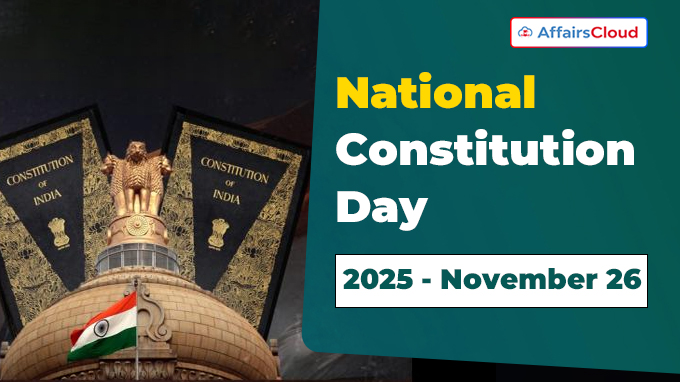National Constitution Day also known as ‘Samvidhan Diwas’ is observed annually across India on 26th November to commemorate the adoption of the Indian Constitution by the Constituent Assembly of India in 1949.
- 26th November 2025 marks the 76th anniversary of the adoption of the Constitution of India.
2025 Theme: “Humara Samvidhan, Humara Swabhimaan” (Our Constitution–Our Pride).
Focus: Upholding constitutional values as the foundation of national dignity, inspiring citizens to reflect on and reaffirm justice, liberty, equality, and fraternity.
Exam Hints:
- What? Constitution Day (Samvidhan Diwas) 2025
- When? 26th November 2025
- Theme 2025: “Hamara Samvidhan – Hamara Swabhiman”
- First observance: 26th November 2015
- 2025 Event: Held in Central Hall of Parliament House, Samvidhan Sadan, Delhi
- Key Releases: Constitution in nine regional languages; Commemorative booklet on calligraphy
- International Tribute: Dr B.R. Ambedkar’s bust unveiled at UNESCO Headquarters, Paris, France
Background:
Declaration: The Ministry of Social Justice and Empowerment (MoSJ&E) announced in 2015 that 26th November would be observed annually as Constitution Day to promote constitutional values among citizens.
Commemoration: The year 2015 marked the 125th birth anniversary of Dr. Bhimrao Ramji (B. R.) Ambedkar, chairman of the Constitution’s drafting committee, and regarded as the Father of the Indian Constitution, the day was previously celebrated as Law Day.
Inception: The first Constitution Day was officially observed on 26th November 2015.
Anniversary: The year 2025 marks the 134th birth anniversary of Dr. B. R. Ambedkar.
2025 Event:
On 26th November 2025, the President of India, Droupadi Murmu, along with Vice-President Chandrapuram Ponnusami (C. P.) Radhakrishnan and Prime Minister (PM) Narendra Modi commemorated National Constitution Day 2025 at the Central Hall of Parliament House, Samvidhan Sadan, New Delhi, Delhi.
Key Initiatives Launched:
Regional Constitution: The Legislative Department (LD), Ministry of Law and Justice (MoL&J), digitally released the Constitution in nine regional languages: Malayalam, Marathi, Nepali, Punjabi, Bodo, Kashmiri, Telugu, Odia, and Assamese.
Booklet: The Ministry of Culture released a commemorative booklet titled “Bharat ke Samvidhan se Kala aur Calligraphy”, highlighting the art and calligraphy of the original handwritten Constitution.
Preamble Reading: Droupadi Murmu led the reading of the Preamble, an activity also undertaken by citizens nationwide through platforms like MyGov.in.
International Tribute to Dr. B.R. Ambedkar:
On 26th November 2025, a bronze bust of Dr. B.R. Ambedkar was unveiled at United Nations Educational, Scientific and Cultural Organization (UNESCO) Headquarters in Paris, France, by the Permanent Delegation of India to UNESCO.
Sculptor: The bust was created by sculptor Naresh Kumawat.
Location: It was installed in UNESCO’s Garden of Peace.
Recognition: Dr. Ambedkar became the second Indian leader, after Mohandas Karamchand Gandhi (Mahatma Gandhi), to have a statue installed at UNESCO.
Significance: The tribute honors Dr. Ambedkar’s contributions to equality, social justice, and the drafting of India’s Constitution, reflecting UNESCO’s commitment to human rights.
Background of Indian Constitution:
Constituent Assembly: The Constitution of India was drafted by the Constituent Assembly, formed under the 1946 Cabinet Mission Plan, which first met on 9 December 1946 and elected Dr. Sachchidananda Sinha as Provisional President.
Adoption: The Constitution was adopted on 26th November 1949 and came into force on 26th January 1950, commemorated as Republic Day.
Permanent Chairman: On 11th December 1946, Dr. Rajendra Prasad was elected as the permanent Chairman of the Constituent Assembly.
Drafting Committee: The Assembly set up 13 committees, including a Drafting Committee under the Chairmanship of Dr. B.R. Ambedkar on 29th August 1947.
Drafting Members: The Drafting Committee originally had seven members: Dr. B.R. Ambedkar (Chairman), Alladi Krishnaswamy Ayyar, N. Gopalaswami Ayyangar, Dr. K.M. Munshi, Syed Mohammad Saadulla, N. Madhava Rau (replaced B.L. Mitter), and T.T. Krishnamachari (replaced D.P. Khaitan).
Points to Note:
Length: The Indian Constitution is one of the longest in the world, handwritten in both English and Hindi, currently comprising 448 articles in 25 parts and 12 schedules (as of 2025).
Word Count: Initially, it had 395 articles, 8 schedules, and 117,000 words; by 2024, it contained 146,385 words due to amendments, making it the longest written and active constitution of a sovereign nation.
Drafting: The Constitution was drafted over a period of two years, eleven months, and seventeen days.
Principles: It defines India’s democratic, secular, and egalitarian principles, guiding governance through justice, liberty, equality, and fraternity.
Preamble: Derived from the Objectives Resolution proposed by Jawaharlal Nehru on 13th December 1946, the Preamble included the words “socialist,” “secular,” and “integrity” under the 42nd Amendment in 1976.
Calligraphy: The Constitution was handcrafted by Shantiniketan artists under Acharya Nandalal Bose, with calligraphy by Prem Behari Narain Raizada.
About the Ministry of Social Justice and Empowerment (MoSJ&E):
Union Minister– Virendra Kumar Khatik (Constituency- Tikamgarh, Madhya Pradesh)
Ministers of State (MoS)– Ramdas Athawale (Maharashtra); B. L. Verma (Uttar Pradesh)





